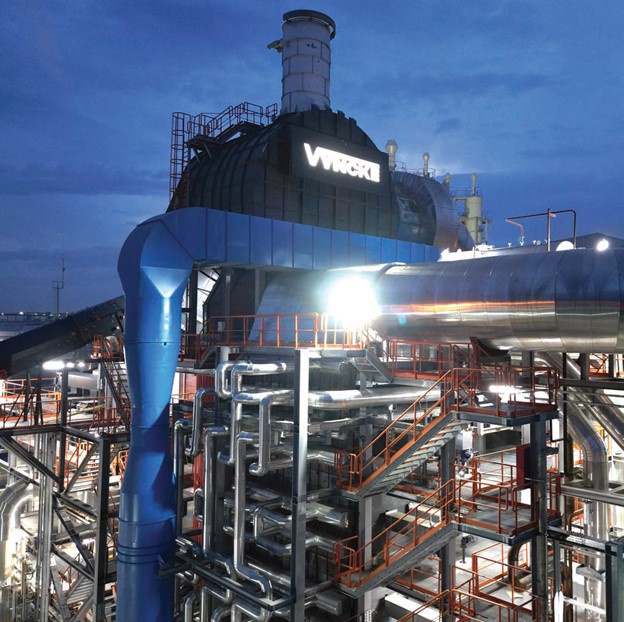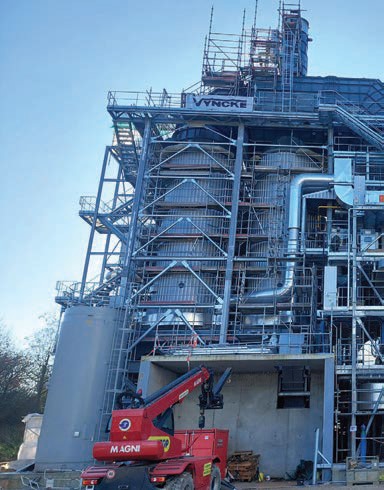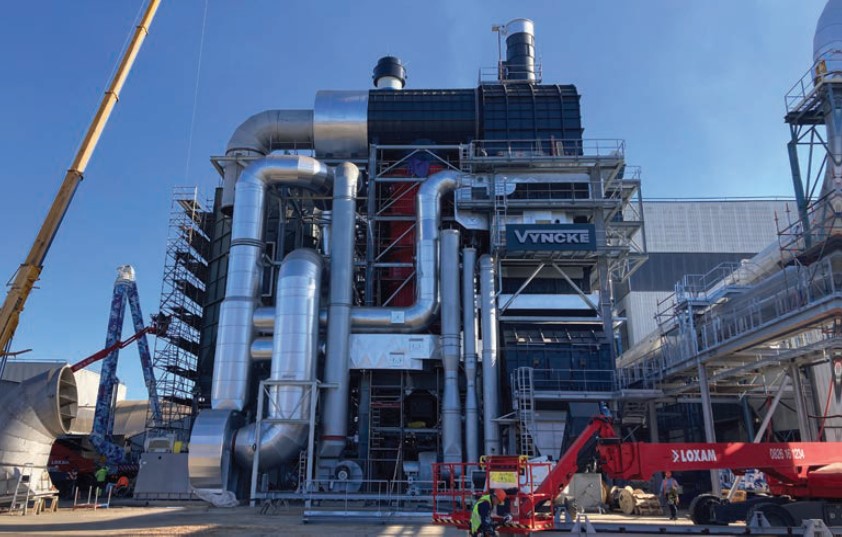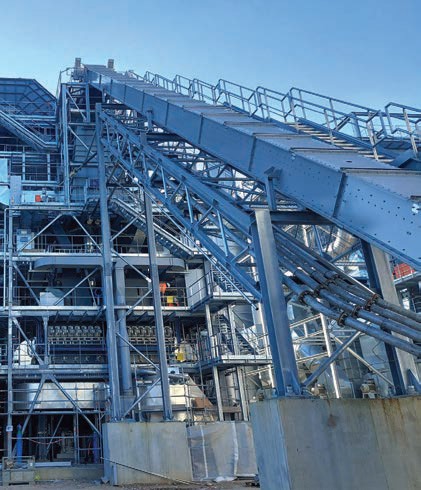Vyncke builds global brand
22 January 2024Vyncke has been in the energy generation business since the 1920s. Stephen Powney spoke to Vyncke chief sales and marketing officer Jeff Mestdagh about the company’s recent developments, projects and the current market situation
Vyncke has come a long way since it made its first foray into the energy sector.
A certain Louis Vyncke established himself in Flanders in 1912 and then in the 1920s the Vyncke name became involved in steam boiler production for the flax industry using flax straw waste as fuel.
Since then, it has been transformed in terms of company size, its geographic reach, the technology offering, the range of fuels burned and industries served.
In 2023 it expected to have a turnover of approximately €200m and supply sectors as diverse as the wood industries, food/ agriculture, industries with high energy consumption and the waste to energy sector.
It also now has offices in Belgium, Brazil, China, the Czech Republic, Germany, Ivory Coast, Malaysia, Singapore, Spain and Thailand.
The company is still family owned (by the fourth generation), with brothers Peter and Dieter Vyncke sitting on the board, as well as running a holding company. They stepped away from operational management of the energy business two years ago to focus on the operations of the holding company and building the Vyncke brand worldwide.
Peter Vyncke moved to Singapore to continue with this entrepreneurship in Asia.
Shareholdings or joint ventures in the holding company include PetroBio AB in Sweden, which specialises in wood powder burners; Callens Vyncke in Flanders – an EPC contractor for full-scope gas-powered cogeneration systems for industrial customers that require both heat and power; Italybased conveyor systems producer Trasmec (a supplier of systems to the wood-based panels industries); Forbes Vyncke Pvt Ltd in India; and Save Energy, a supplier of flue gas condensers and carbon capturing technology for bioenergy plants.
Previous COO Stefaan Lauwers, a former director at panel producer Unilin, stepped up to the position of CEO and is now leading the energy business, which now comprises more than 400 staff, or ‘Vynckeneers’ as they’re known.
DEVELOPMENT TRENDS
For the purposes of this update the focus is firmly on Vyncke Clean Energy Technology which builds biomass and waste to energy solutions, with the wood-based panels industries of course being a prominent customer.
Vyncke chief sales and marketing officer Jeff Mestdagh emphasised to WBPI that the key focus with the company’s energy systems was solid fuels.
Firstly, there is the wood industry, which represents one of the company’s oldest customer sectors – extending from sawmills to wood-based panel manufacturers and pellet producers worldwide.
Secondly, there is the agro and food business – where Vyncke encounters a vast range of side streams from production, such as sunflower hulls, spent coffee grounds, palm kernel shells, rice husks and malt dust.
The third strand of business originated when Europe made a move towards renewable energy, shifting from fossil fuels to biomass fuels – they do not have their own fuel or waste to burn.
“You always compete with fossil fuels,” explained Mr Mestdagh.
“If oil and gas prices are high you compete and there is business but if it is low then there is not so much business. But there is still a subsidiary scheme in Europe for investments in biomass energy schemes.”
Fourthly, some years ago Vyncke entered the waste to energy business, developing technology for dealing with other waste materials, such as refuse derived fuel (RDF).
The first application was a power plant in the UK, near Birmingham, running purely on RDF to produce electricity, followed by a project in Sweden, providing heat to the town of Säffle.
“We see a trend that industries are looking into this fuel,” added Mr Mestdagh.
Vyncke currently has a project at a sawmill in France, where the client will use RDF to make energy for its production process, in this case a co-generation plant that will generate 5MW of electricity combined with another 15MW heat.
“Biomass will always find another purpose, as biomass waste to make energy should always be the last resort,” said Mr Mestdagh.
Many panel producers are using wood waste as feedstock to make new panel products.
“We strongly believe in giving priority to reusing the material rather than burning it,” said Mr Mestdagh. “On the other hand, there is a lot of waste, so we want to solve the waste problem. Our way to do that is making energy out of it.”
Vyncke has seen how some industries, which need considerable amounts of energy for their production processes, are starting to look into using RDF on top of their own waste from production.
“I thought it would mainly be power plants or district heating plants using RDF, but we see the industry is now looking into this,” said Mr Mestdagh.
The France-based wood industry company putting in Vyncke’s first wood sector RDFfired co-generation plant is Piveteaubois. Vyncke already has RDF applications in other industries.
“We hear wood-based panel producers talking about burning RDF to create energy, but the permitting process is complicated – with RDF you are entering the waste to energy market where there are more stringent conditions.
“For panel applications, you need 50-100MW of heat for an MDF or PB line and you need the material close to the plant. If you have to transport it from far away it becomes complicated.”
Mr Mestdagh believes the panel industry will see a large RDF-fired energy system at some point in the future.
A major trend in recent years has been decarbonisation, something Vyncke believes is a long-term trend. The current high interest rates may be a dampener on investment decisions currently but there are still many projects – with France, Germany and Scandinavia being examples due to the availability of investment subsidies, so customers are able to receive subsidy help immediately rather than wait to receive financial help based on energy generation when the new plant is operational.
“In the wood-based panels industry there are companies going through difficulties in selling their products and maybe shutting down lines or reducing their capacities,” said Mr Mestdagh.
“If you’re reducing capacity, you do not need energy plants. But in the panel industry we didn’t do that bad in 2023, it was quite OK and we sold a number of plants.
“In Europe we see more and more brownfield investments by the industry and a need to replace old energy plants, even when there is not necessarily a new press line. Also in Europe, you see more often a shift from rotary to belt dryers, that means you need another energy plant, not one that generates hot gas but one that generates hot water.”
This latter trend represents good business opportunities for Vyncke. But the company does not expect 2024 to be a stellar year for wood-based panels sector investment, due to the economic headwinds.
PROJECTS
Vyncke is currently executing about 60 energy plants in 35 different countries.
In Germany, the company is commissioning a 34tph steam boiler for GUTEX at Eschbach. The energy is for an insulation board line. This is the second project for GUTEX (the first was for a line at Gutenburg).
In France, Vyncke will commission an energy plant at Swiss Krono at Sully-sur-Loire in Q1. It will generate 18MW thermal oil and 65MW of hot water for an OSB and PB production line. The hot water is mainly for two new belt dryers from IMAL PAL Group.
The customer is the EPC contractor Dalkia, which will operate the plant for Swiss Krono.
“This sort of arrangement is quite common in France, with many energy contractors and energy companies that come up with solutions for industries,” explained Mr Mestdagh.
Vyncke also recently commissioned a new energy plant for Unilin in Ussel in a typical brownfield project where also the MDF dryer has been renewed.
Another recent commissioning is a thermal oil heater for De Sutter Freres, a company in Normandy that uses 100% flax waste as raw material to make PB. This heater uses flax dust for fuel.
Looking worldwide, Vyncke is involved in projects in Australia, with two orders for Borg.
One is the energy plant for an MDF line previously belonging to Dongwha and the second is for a new 2,000m3 daily capacity PB line.
Moving on to Vietnam there are two projects – the first is an energy plant for Kim Tin for its new MDF line in Dau Giay.
The other project is for Staboo, which will use bamboo as a material to produce OSB. The Vyncke plant will generate energy from bamboo waste.
Mr Mestdagh explained that bamboo, like all woody biomass that comes from fastgrowing plants/trees, is more difficult to burn because there is more potassium.
“This has its challenges. You have to make the necessary adjustment on the design of your energy plant. If you are not aware of the challenges of burning bamboo waste, you can end up with a problem.”
Two projects in Vietnam (with Vyncke energy plants) were cancelled (Dongwha VRG and Kim Tin 2) due to the absence of building permits.
In Brazil, the company is building an energy system for Sudati, while in Turkey, Vyncke is currently commissioning two 100MW energy plants for Kastamonu Entegre (one at Balikesir and a second at Kastamonu City). Both energy plants are generating 66MW thermal oil and 30MW hot water and they are driving a 14MWe ORC turbine.
Vyncke says there are some wood insulation board projects in Europe coming, but this sector has been slowing down.
One area seeing strong interest is carbon capture technologies.
Vyncke is active in the agricultural sector – particularly the greenhouse plant growing sector, with growers of tomatoes and zucchini.
“This trend will happen soon,” said Mr Mestdagh.
“You will have a biomass-fired system to heat the greenhouses, then capture the CO2 from the flue gases and use it back in the greenhouses to give it a boost for the plants to grow. Farmers are buying CO2 these days and there will be no need to buy CO2 in the future, but to use the CO2 from the biomass boiler.”
Vyncke has already built two such plants in the Netherlands. One is with hot water and another is a CHP plant – making electricity, heat for the greenhouses and producing CO2.
“You do not need to liquify the CO2, so the cost is lower. This is a quite a unique carbon capture method from energy plants. I do not know anyone else that has such experience with carbon capture from biomass energy plants.
“What we have built is not a prototype, it is actually running on an industrial scale and running at full capacity,” said Mr Mestdagh. “It can be replicated.”
Another important trend for Vyncke is the emission requirements, which are becoming more and more stringent, therefore pushing the company to design and make plants that are more high performance with fewer emissions.
The shift among PB and OSB manufacturers to move from drum dryers to belt dryers is an example of the industry requiring fewer emissions – as belt dryers are viewed as more environmentally-friendly. This shift has seen requirements move from hot gas to hot water.
The second advantage of specifying a belt dryer is you can additionally generate electricity because you can build cogeneration plants. These investments can be very substantial.
In summary, Vyncke has grown its business considerably in recent decades and the fact it can point to an average annual growth rate of 15-20% speaks for itself.
The trajectory of worldwide demand for energy systems across the different industries is likely to only increase in the coming years. The interest and focus on energy systems from the wood sector at the Ligna exhibition in 2023 is surely evidence of that.



